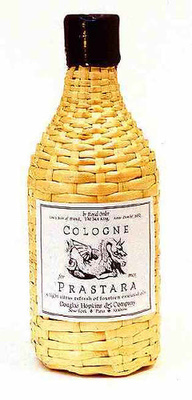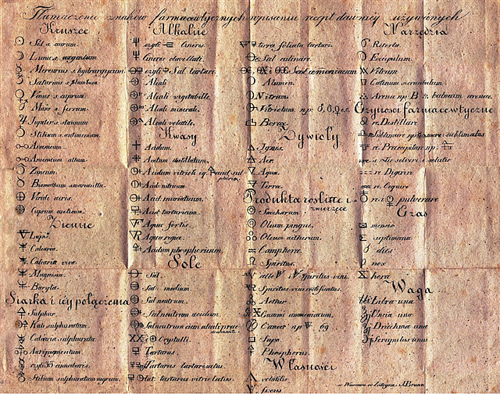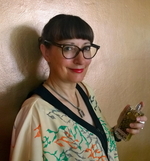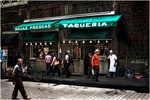Interview with Douglas Hopkins of DH & Co - Part I: The Story of Prastara & a Fashion Photographer Turned Fragrance Developer {Passion for Perfume - Portrait} {Celebrity Fragrance}

Marie-Hélène Wagner: The story of Prastara seems complex; I see that there is a Polish brand that sells a similar product. Do you have any information about that other Prastara?
Douglas Hopkins: The short story is that I bought the Prastara trademark from the Poles back around 1987, from a trip with a fragrance industry expert, looking for investments after the Wall went down. The Communist factory keeps the domestic Polish market, I have the rest of the world. I've since created three other scents, Prastara Blue, Åse (OH-say), and Zazou. I was friends with a number of European royal families, stemming from portraits I did during twenty years as a New York fashion photographer, and through their exquisite private castle libraries (You can yet see a photo of one on the first page of our old site www.DouglasHopkins.com). I found intriguing formulations, which I used in creating my scents. With my background as a volcanologist at MIT/NASA, I expanded into geothermal-based skin care products, which did exceptionally well. They were licensed a few years ago and are being redesigned for a new launch. We made an unintended splash in the fashion press for a $800 per ounce "Deep Sea" limited edition, therapeutic mud, which sold out at Bergdorf Goodman in a week. We have been more or less exclusive to Bergdorf's for 15 years, but are now expanding into a wider market. We have been a hit in Italy for a decade, and recently entered Galeries Lafayette in Paris, the first American niche fragrance in the store. These are a few of the highlights........


MHW: Can you tell us a bit more about your journey to resurrect Prastara and its history?
DH: My role was initially limited to moving Prastara from its widespread distribution, entirely hidden in Communist Russia, to Western fragrance counters. One doesn’t think of a fragrance as a Cold War item, but it was entirely unknown here. With a modest start it resurrected itself! I tweaked the package somewhat and listened to several consultants mispronounce "Prastara" while telling me it was an unworkable fragrance name. That was a hard decision to make; it is easier to name a child than a fragrance! One can recover from a bad name, a fragrance can’t! Prastara is loose Russian slang for "ancient", in reference to its Sun King pedigree. This word comes from the root word "stara" meaning "old".
My journey was a personal one of learning about fragrance retailing, and later investment capital, in order to support Prastara in the style to which it had quickly become accustomed on the shelves of such exclusive stores as Bergdorf Goodman, our flagship of almost 15 years. Over the course of those early years it passed through
Barneys and Bendels, where it was given its start by an astute buyer, Ed Burstell;”Polish perfume? Sure, c’mon over and show it to me!”
In twenty minutes we had a handsome $3500 opening order, and were off and running, soon selling out. At that time Bendel's did not have a men’s fragrance department, nor did they cater to men’s fragrances, but they had a superb women’s fragrance sales manager and through her I discovered that women buy Prastara more readily than men. Much later it became the inspiration for a rather downscale “knockoff”, called “CK-One”; a so-called “unisex” fragrance of huge popularity. But this is another story.
Prastara's popularity rests on the fragrance itself, the packaging, and its pedigree. The fragrance is suitable for both men and women, the wicker gives it a distinct, "automatic" gift appeal (Like Bay Rum.) and the Sun King is our "pedigree". It is not only acceptable to both men and women wearers, we’ve also gained a number of the most difficult customers, those who usually say “Can’t wear/don’t like fragrance, period.” Why? Without question, this is due to the exceptional top-note freshness of two lemons: lime and orange.
MHW - Do you have any factual information that shows that CK-1 was inspired by Prastara or is it just an intuitive guess on your part?
Douglas Hopkins: Imitation is the sincerest form of flattery
How did this all start? In my fashion photographer days, I met the famed and beautiful, N.Y. City Ballet, Russian, Bolshoi Ballet, prima donna, Cold War defector, Valentina Kozlova…in the course of doing her portrait. (Her history in a sentence!) For many years hence I have enjoyed a wonderful friendship with this intensely private artist, sometimes named the “female Baryshnikov”. Unlike his up-front personality, she spurned publicity, spoke only with her magnificent performances. One evening over dinner, Valentina, myself, and another fine Russian immigrant friend, George Diamond -- my mentor in perfume production, for which he holds many patents - - were discussing what might happen if Communism fell; as it turned out it was about to.
George came up with the idea of creating a “Valentina” fragrance and multi-level market (“Avon”) it in Russia as a new “capitalist” experience, using young Russian ballet students, whom Valentina could readily reach in workshops. It became one of those dinner conversations that took root. I spent research time at the New York Public Library and discovered that “quality” Russian cosmetics were mostly made in Eastern Europe. This was something the first Russian fashion models to New York later confirmed to me, that domestic Russian eyeliner usually yielded an immediate eye infection!
Six months after the dinner, however, the Wall fell and George and I were off to inspect Eastern European cosmetic factories. We were welcomed to the most primitive operations that George, in his 70’s, had ever seen. Horse drawn carts of coal chunks the size of boulders for heating. No automation of any kind, almost all was manual handwork of 100 years ago. In each we were eagerly welcomed, solely on the basis of being the first Americans to visit, as economic saviors of factories with three times more workers than they needed by the most basic Western standards. It was a sobering first peek behind the Iron Curtain. As far as distributing in Russia, the mafia took over so quickly we saw it as too dangerous. One of the TV networks did follow Valentina’s triumphant return to the Moscow Bolshoi at Gorbachev’s personal invitation, resulting in a mesmerizing US documentary. It was on my last day of the inspection trip, George had already returned to the US, that I stumbled, on a tiny, remote fragrance plant via local word of mouth, way out of town. The moment I walked into the modest building, I smelled a great scent! Bolt of fragrance lightning hitting an all-American, Old Spice high-school, average type guy; “nice reek at the wrong time”. It was an intuitive, knockout nose impression. I knew nothing about fragrance. As any person in the industry will tell you, there is a certain distinct smell to fragrance factories. It is the accumulation of so many different fragrancing ingredients combining and is somehow always the same, no matter where the place or what the brand is. It is the smell of the refrigerator where our company controls samples, and my personal collection, is kept. It isn’t a bad smell, but it can be overwhelming to some, as it is strong and doesn’t beckon!
Well, this tiny factory was different, it was clean, clear, and fresh: Prastara. I later figured out this was due to being a Communist-run co-op; it had only one product, one fragrance, and nothing else, not even “line extension” of soap or lotions, so it had no “olfactory conflicts”. When I acquired the Prastara trademark from that now ex-Communist factory, I closely questioned them on the pedigree. It had been apparently manufactured by two Russian-controlled, Eastern European factories since the end of World War II. The exact origins are difficult to uncover as the oil (The so-called “juice”, a term I don’t like.) was supplied by an obscure Russian oil source, where – and, as with all of the flavor and fragrancing formulators, information is traditionally kept extremely confidential.
The factory did offer a rough text, that the original formula was found in the archives of a 700-year old Polish soap factory. The high probability was that this factory had a connection with Louis XV’s royal Polish mistress and later wife [Editor’s note: Marie Leczinska]. The factory related that the original documents were stolen in the 50s and never recovered. This remains an ongoing research story and I look forward to any possible clues or contributions The Scented Salamander readers may offer. In addition to this opening narrative, I would like to share a few details of “romantic scholarship”, a personal “American- in-Europe" episode that I deeply cherish.
So this story doesn't seem too pompous, let me firmly state I am happily living out in the countryside corn fields with my wife and three year old daughter -- although with a Firmenich scent factory only a few miles away! It was during my twenty-year career as a fashion photographer in New York City that I was given a few opportunities to mix with the rich and famous. I stood in awe, along with a fortunate measure of technical competency, actually photographing teen-aged Phoebe Cates, her spectacular sister Valerie, Sharon Stone, Alexandra Paul, a very shy Mia Farrow, and even Andy Warhol. One also tried mixing socially to order keep the “fashionable reputation” going, even though I owned only one suit and an ill-fitting tux. In my opening New York months, I did extensive photography of fashions and celebrities for Women’s Wear Daily, then going on to work for Vogue and many of the other fashion publications and clients, such as Oscar de la Renta. Over the course of meeting much “fluff”, there were really interesting exceptions, several of Norman Mailer’s family members, for example, Kate Mailer, whom I shot for British Elle magazine. I soon discovered no one objects to having a nice, free studio photograph taken of oneself, as long as the prints are sent quickly! Of all of these sparkling personalities, along with Valentina, one of the most interesting persons whom I met was a bright young German engineer; it turned out we shared an avid interest in then burgeoning personal computers. He is a “real Prince”, from one of the very oldest European families, and his very attractive wife was also a “real Princess” even before she married him. We became friends over the years and, unknowingly, they became “cultural” mentors for me. I am a middle-class American who grew up on a military base in Alaska, Eagle Boy Scout, a nerd before the word existed, way too shy to talk to the pretty girls in high school. This couple graciously showed me how the refined, well- educated side of cultured European society functions, quite a fascinating difference from our pragmatic American “get it done” culture...which they do admire, the Chairman of LVMH, for one outstanding example. I had spent a year of high school in Germany learning the language, so I already had a keen interest in the differences between the Old and New World's. I tell this long story as you will find this lifetime experience of a foot on two continents deeply embedded in my fragrances.
Back to my “royal” friends: whenever our paths crossed in Europe, this wonderful young couple would invite me to accompany them to exotic social events or to visit -- and even sleep in -- one of their three or four out-of-this-world castles. Way cool! In a token return, I took photographs, keeping them quite private, as is their lifestyle. In the course of these years they experienced the high points of my transition from photographer to perfume designer. On one such European visit the wife invited me to stay overnight in her parent's Austrian "Schloss", once the home of the Archduchess of Austria and Holy Roman Empress, Maria-Theresa. Waking up early the next morning I had to thread my way to the kitchen for some coffee (pre-GPS days), wandering alone through this ancient, magnificent mansion. Along my trek, I encountered the castle library, not the first, nor the grandest I'd seen of theirs, nevertheless right out of a movie set! Even at this early hour there was a librarian working there, who, quite oddly, did not speak English. Maybe she wasn't a librarian? I was early on in my quest for Prastara information, and being a persistent researcher, I managed to convey my interest to her in perfuming. Whereupon – very pre-Potteresque -- she rolled one of those long wheeled library ladders to an exact spot, hustled up the rungs, pulled out a leather bound, paperback sized book, literally blew dust off it, and bounded back down the ladder to hand it to me...then politely went back to her desk. I did finally find the kitchen. My friend's father graciously took the book to his office, and that evening returned with a small, exact Xerox copy, page for page! It is a rare, early 18th century perfuming manual. This book significantly propelled my fragrancing activities from then on out. It was particularly useful when I worked with the large international oil suppliers, accustomed to clients of much greater sophistication in these matters than I innately had. This book founded the ultimate direction of my company, as reflected in our motto "Purveyors of fine royal, ancient, or lost apothecarial discoveries."
There is a final twist in my saga of Prastara history. A few years ago I was attending an enjoyable Prastara launch in a chic crowded SoHo boutique, when a fashionable dressed, sixtyish woman, pops out of the crowd, approaching quite firmly, stating, "I'm a lawyer, and my great-uncle revived and originated [modern] Prastara!" Quite taken aback at the first portion of her statement, I could only think to stutter, "Does it smell the same?" "You bet!" was the approximate reply. Requiring a breather, I was more or less able to let her go at that with a following week lunch appointment. It turned out she was indeed eccentric, abrupt by nature, and her story it would appear, was amazingly true. As aggressive as her behavior was in approaching me at the opening, she did later justify it by telling me that unexpectedly smelling the Prastara scent brought back a wave of memory of her quite long past relative. This is a story I hear often, and most especially with Prastara, that it brings back cherished memories of long gone Eastern European and Russian relatives. This is one aspect of the book I'm working on, "Real.Views", about the persistence of sense-activated memory and how it can be used, through photography, to form in each of us gratifying creativity..........
You can read Part II of the interview










Very nice and interesting story. But I think some aspects (the east european factories) are exagerated. I know quite well that world and system, the perfumes, the productions, the formulas and a lot more .... and if East Europe was a mystery for USA it doesn't mean it was that primitive...You'd be surprise to know how many formulas from Givaudan, Haarman &Reimer, Dragoco, etc were around ... not to speak about industrial espionage (cosmetic science). And how to find a formula in the communist block? it's not that complicated and the secrecy we are used to in Western Europe was a different concept. Never forget that in EEurope economy there was no competition (one of the factors to the secrecy in fragrance world).
I wait your next post and very curious about the story ... and of course to smell Prastara!
Dear Readers,
as the former purser aboard the Polish Ocean Lines passenger liner the tss Stefan Batory please be informed that the Prastara has been for dozen of years the greatest hit ever. The scent which I will never forget. Regardless of the wonderful history (me personally as the recognised KLM Aviation Historian) I would love the form how the history of the Prastara had been shown and so wonderfully commented by Doug's photographs which all qualify to be highly praized and nominated for Oscars. Your interview was a great thing for me.
You brought me and my wife to the wonderful world of
scent.... and this was so creatively done with your touch as an artist of the highest rank. Phenomenally. Thank you for this wonderful interview. I am looking forward to seeing the next part of it.
with Christmas Wishes to all Readers as well as the two interview parties...
Andrew Beniger and wife Bozena
Vienna, Austria
Thanks for your compliments. With regard to the industry, we may be talking about two different aspects. We toured only Poland and looked at production factories. The ones we saw in mid-1980 were primitive by any Western standards of the previous 50 years, but that is not to say they could not produce acceptable goods. We found a guy making lipstick practically in his living room, with really impressive machinery he had built from scratch. Not easy to make lipstick. In the case of Prastara, the handwork, willow weaving on the bottle, could not be done any other way. We found in general the Poles knew nothing about distribution as that was almost entirely in Russian hands. I wish I had taken more photos, but in general I felt it might be intrusive. The postscript is capitalism has moved at lightning speed, Western capital and expertise moving in, and local entrepreneurs revving up!
You are right on about "no competition". That was amazing to us; no sales staff to speak of, no customer service, no advertising at all! No trademarks, no deeds, very little bookeeping. More time for your family!
Nobody know anything about distribution in those countries.
Poland had the strongest expertise in cosmetic products (creams) in that period in EEurope. LOreal started to collaborate with them in the 80s and I think also that for a short period of time even western perfumes were produced (bottled). The consequence is that now ... Avon, P&G, Unilever and all other major actors in cosmetics have their factories there and no in other EEuropean country (except Russia, but that's a different story).
What you saw is a typical part of EEurope economy in the late 80's - people were aloud to produce goods at home and sell them in the market.
Prastara basket was for polish market or for export? Because in Bulgaria too there were this kind of artisanal work used mainly as a propaganda item for foreign visitors or to be sold in western countries.